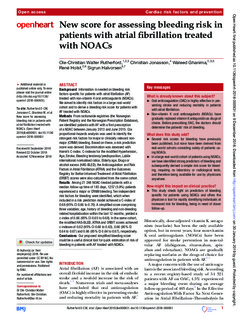| dc.description.abstract | Background
Information is needed on bleeding risk factors specific for patients with atrial fibrillation (AF) treated with non-vitamin K oral anticoagulants (NOACs). We aimed to identify risk factors in a large real-world cohort and to derive a bleeding risk score for patients with AF treated with NOACs.
Methods
From nationwide registries (the Norwegian Patient Registry and the Norwegian Prescription Database), we identified patients with AF with a first prescription of a NOAC between January 2013 and June 2015. Cox proportional-hazards analysis was used to identify the strongest risk factors for major or clinically relevant non-major (CRNM) bleeding. Based on these, a risk prediction score was derived. Discrimination was assessed with Harrel’s C-index. C-indexes for the modified Hypertension, Age, Stroke, Bleeding tendency/predisposition, Labile international normalised ratios, Elderly age, Drugs or alcohol excess (HAS-BLED), the Anticoagulation and Risk Factors in Atrial Fibrillation (ATRIA) and the Outcomes Registry for Better Informed Treatment of Atrial Fibrillation (ORBIT) scores were also calculated from the same cohort.
Results
Among 21 248 NOAC-treated patients with a median follow-up time of 183 days, 1257 (5.9%) patients experienced a major or CRNM bleeding. Ten independent risk factors for bleeding were identified, which when included in a risk prediction model achieved a C-index of 0.68 (95% CI 0.66 to 0.70). A simplified score comprising three variables; age, history of bleeding and non-bleeding related hospitalisation within the last 12 months, yielded a c-index of 0.66 (95% CI 0.65 to 0.68). In the same cohort, the modified HAS-BLED, ATRIA and ORBIT scores achieved c-indexes of 0.62 (95% CI 0.60 to 0.63), 0.66 (95% CI 0.64 to 0.67) and 0.66 (95% CI 0.64 to 0.67), respectively.
Conclusions
Our proposed simplified bleeding score could be a useful clinical tool for quick estimation of risk of bleeding in patients with AF treated with NOACs. | nb_NO |

